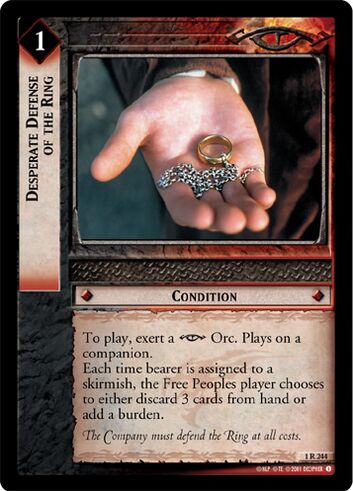The 2022 Yuletide Errata have been promoted to all PC formats! In this post, we will go over each of them one by one and document our thinking behind why each one deserved a change and why we landed on the change that we did.
Many of the buffs given below were attached to cards that we confirmed had an atrocious usage rate–Stormborn Slade, a member of the PC, did some analysis of games from 2020 and 2021 to produce a ranking of cards used from 100,000 replays. Cards chosen for buffs usually had usage rates of less than 100 out of those 100,000 replays. You can view the results here if you’re interested (make a copy of the spreadsheet if you would like to change filters and sorting).
PC-FOTR+ Misc. Buffs
In PC-FOTR, Nazgul are running amok. It’s unclear if this is simply down to people being excited about playing Nazgul again in a post-Flaming-Brand world, or if it’s an indication of actual unbalance in their direction. We will keep a keen eye on them, but in the meantime we decided to add a number of minor buffs to Ringwraith counters (including Brand itself), and a few minor buffs to things that are not Ringwraith, just to give people a small push in the direction of some other Shadows.
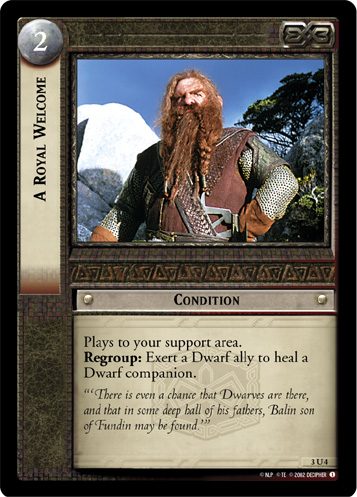

A Royal Welcome, barely used, is granted an ability that permits Dwarven companions to get a strength bonus against strength 10+ minions, which is most Nazgul and many other beefy minions as well. To be able to use this more than a handful of times, a third ability has been added to let you heal up those allies with your companion’s vitality. Speaking of allies…
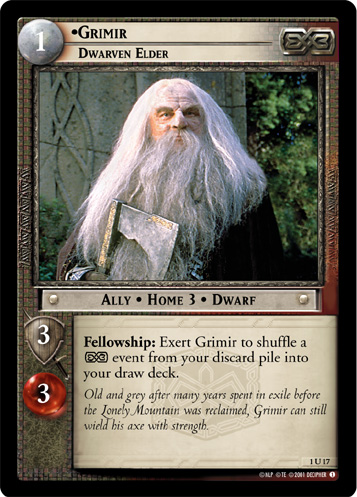

To give you an option of ally to use besides just Thrarin, Grimir has been reworked slightly to replace the top card of your draw deck with an event, which can then be retrieved or interacted with by other cards such as Delving or, well, Deepest Delvings.
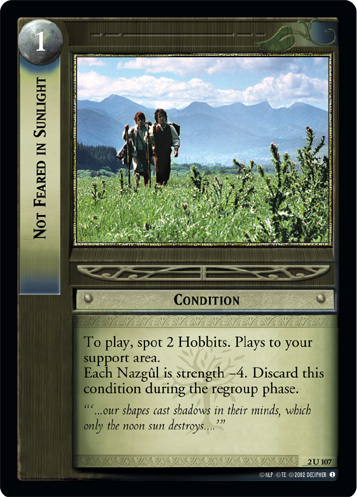

Not Feared in Sunlight is a powerful Nazgul counter, with the major downside of requiring you to hold onto it until the time is ripe, much like an event. To alleviate this, it has been given the same treatment as There and Back Again to let you get a slot in your hand back until you’re ready to use it. In the meantime, The Pale Blade might snipe if you wait too long!
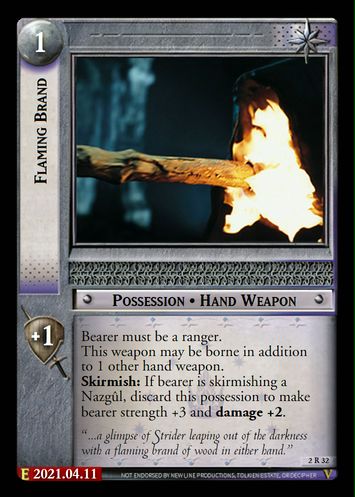

The first errata for Flaming Brand may have gone a bit far–it restricted its usage to only a single skirmish, and since most Nazgul are fierce, that meant losing half of your skirmishes even when utilizing it.
Instead of “throwing” the Brand, you now “light” it, getting bonus strength and damage so long as you hold it (so Cantea can still ruin your day!), and then the Brand will “burn out” in the Regroup phase. Multiple Brands may be lit if the situation warrants, but only lit Brands will self-discard.
Overall, this feels like a better place for the Brand to be in.


What’s this, a buff to a Ringwraith card…? Yes, and one that hardly ever saw the light of day. The original text has been buffed to exert that minion to make a Nazgul damage+1 for both of its skirmishes, and a new choice has been added for a Nazgul to instead exert to make an Isengard minion untouchable.
There are a few Isengard minions that could mesh well with Nazgul with this effect – Uruk Spy and nearly any Isenorc would mesh well with a Twilight Nazgul strategy, particularly Isengard Warrior.
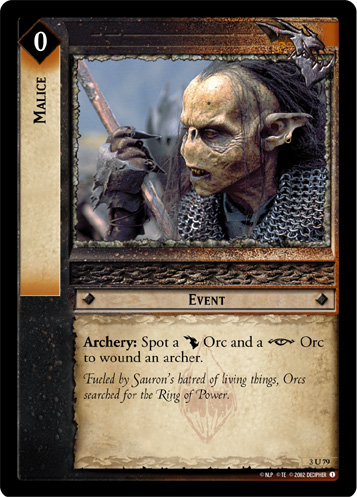

Another of the unused dual-culture card cycle from ROTEL, Malice’s payoff simply wasn’t worth the deckbuilding restrictions. Now, 2 items (possessions or artifacts) from either culture may be played from discard–recycling out-of-reach Scimitars of either flavor, or in later blocks perhaps retrieving a used Ithil Stone…? The number of wounds is bumped up to 1 per retrieved item, which is enough to put any overreaching Greenleafs or Gorn Bowmen to task.
The ability has also been moved from Archery to Maneuver. (This was entirely done because otherwise you could retrieve Cave Troll’s Chain without giving Freeps a chance to skip the Archery phase; it was funny to see this done after Gondor Bowmen had been used twice, but it was still perhaps too punishing.)
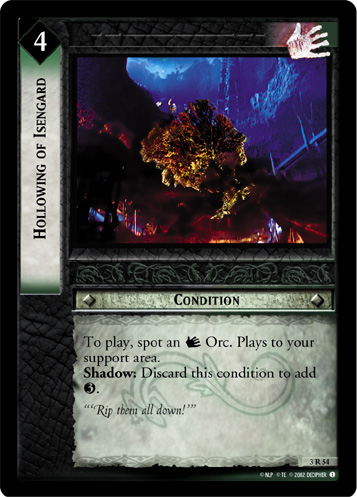

Hollowing of Isengard was always painful to use–spend a lot of twilight now, hope to get some of it later, but probably not before it gets hit with Sleep or Secret Sentinels.
Now the interruption is still possible, but the twilight payout can now happen each phase, so long as you sacrifice one of your Isengard cards to do it.
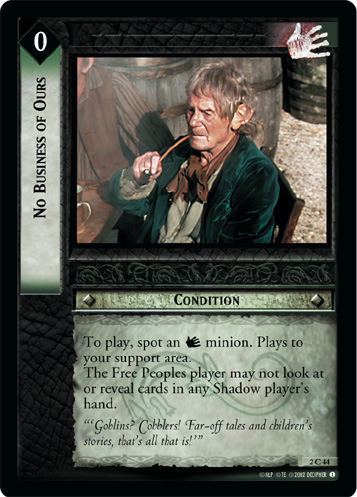

In an unorthodox move, we have decided to make the hand-concealing effect of No Business available to any deck, albeit much cheaper for Isengard decks. The primary reason for this is not actually within Fellowship Block, but to be used as a counter for Drawing His Eye and A New Light (see below) in later formats. No doubt it will see some use in the smaller formats to avoid getting Stung so much.
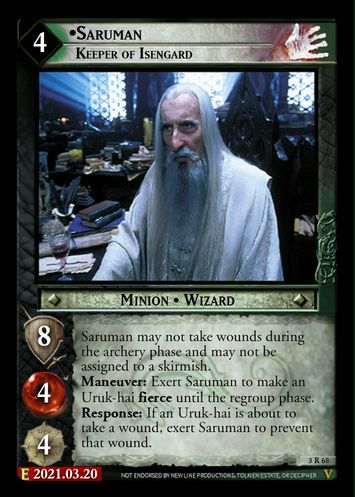

The thrust of Saruman’s errata is still more or less fine, but he’s essentially useless once he’s blocked 3 wounds or made 3 uruks fierce, unlike the original who would at least still provide the fierce bonus.
We’ve added the ability for Saruman to protect one more uruk wound by self-discarding (the wording only permits it to be used if he is exhausted), which means you can play a second copy next turn if the Fellowship decides to move again.
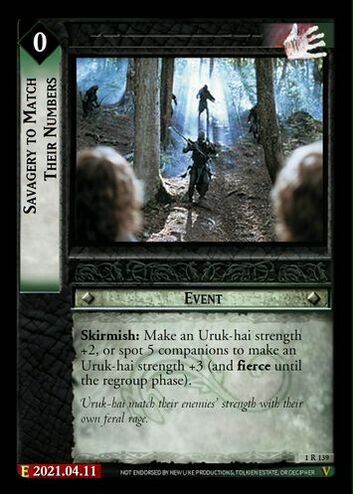

This is a day for revisiting Overtuned Errata of Christmas Past, apparently. Two changes have been made: first, the card has essentially been reverted to the original form, except that the strength bonus for the first skirmish is +4 while the second skirmish is only +2 (instead of +4 for both), and the twilight cost of the event has been increased to 2, requiring that you either utilize Saruman’s Ambition or give away what you’re doing.
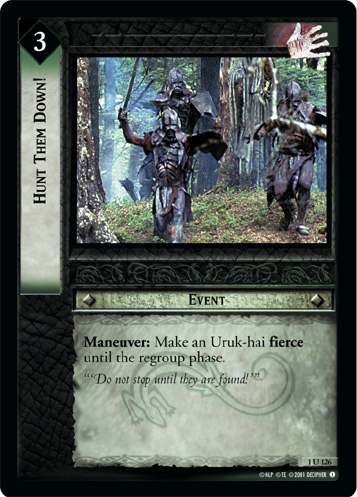

To give Savagery a little competition, we’ve buffed the almost never-used Hunt Them Down: its twilight cost was reduced from 3 (essentially the cost of another minion) to 2.
PC-FOTR+ Misc. Nerfs
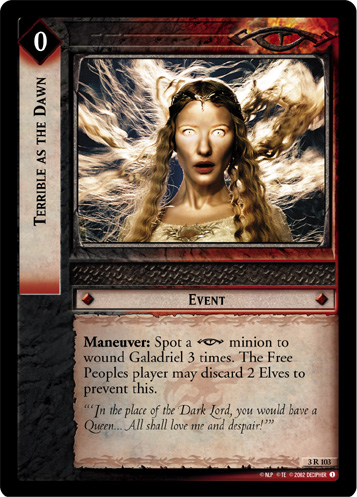

As much as one might hate Galadriel, the ARB version doesn’t deserve to have a card that outright wins the game against her, especially when it’s easily carried by Besiegers, who do just fine without it.
If Galadriel is Ring-bound (probably the Ring-bearer, but you never know!), the Free Peoples player now has the option of choosing to discard 2 Elves or add 2 burdens, which can still be punishing but isn’t an insta-win.
PC-Movie+ Misc. Buffs
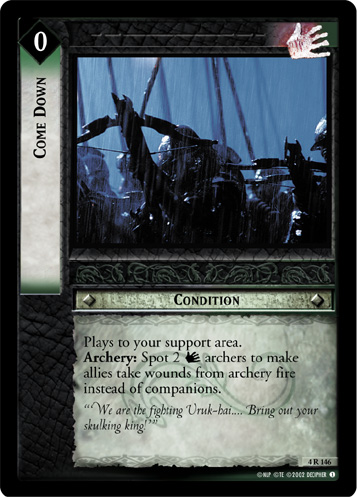

Isengard in general is really only used in Movie when there’s a need for Saruman’s Power to counter a condition-heavy Free Peoples meta. This is a shame, and one of the things that set V2 will be looking to rectify in the months to come–but that’s no reason we can’t help them out now!
Come Down has had an ability added to permit the discarding of fortifications, which means this is really targeting Gondor Knights. The price is costly, but also avoidable–the wounds are not a cost to the fortification discard, so if you can find a way to prevent wounds, well. Maybe that fortification isn’t so unassailable after all.
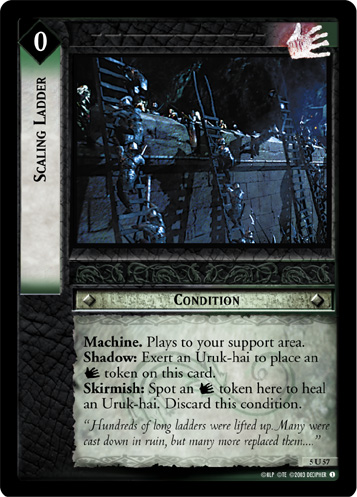

An errata requested by a member of the community, this card bolsters the Berserker cycle of cards by permitting multiple wounds to be healed, instead of just one per Ladder.
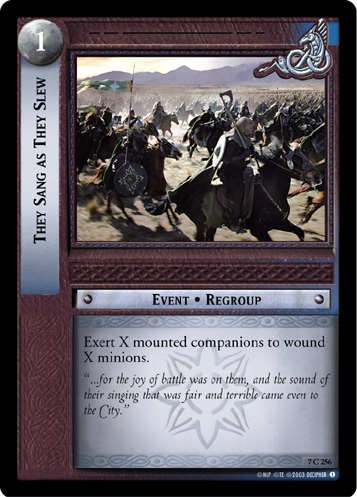

Another barely-used card, and like Isengard, Rohan struggles somewhat to stand out in Movie. This also continues our long-term plans to make burden removal (and other kinds of removal) available to more cultures to lower the bar for what cultures are “allowed” to participate at high levels.
This is the cheapest of the burden options we have introduced, with both Sam, Son of Hamfast and Gilraen’s Memorial requiring 2 (or so) exertions per burden removed. They Sang is 1:1, at the cost of needing multiple mounted companions with spare vitality, and not being (easily) repeated as an Event.
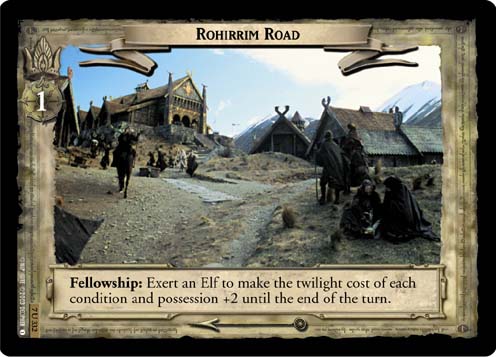

This one is a twofer, as both a nerf to Elves (who need no help dealing with conditions and possessions, and who are particularly disgusting when combining this with Dauntless Hunter) and a buff to Rohan.
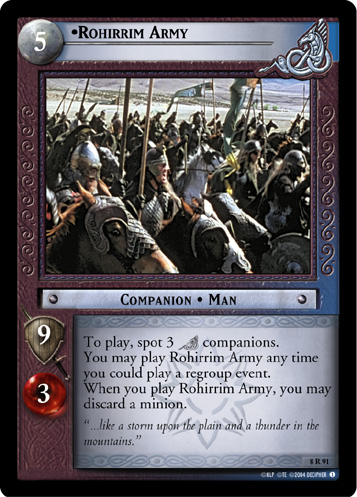

“We never thought we’d be buffing cards from set 8.”
“Well how about buffing a friend?”
“Aye, we could do that.”
(The number of Rohan companions required has been reduced from 3 to 2.)
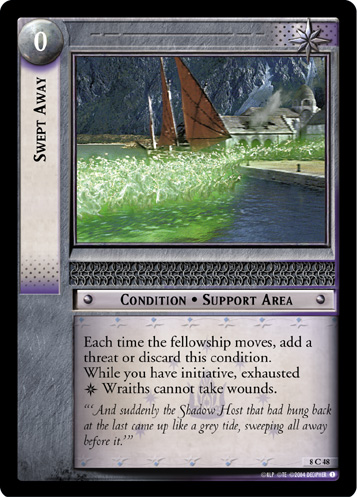

Another community suggestion, this helps out the Gondor Wraiths by making their cornerstone condition a little harder to remove. And although it might be resistant to removal, it does require you to discard cards from hand, which very well could bring you out of initiative, losing its ability anyway for a turn (even if you do rescue the condition itself for later).
PC-Movie+ Misc. Nerfs
Don’t forget that Rohirrim Road from above counts as a nerf!
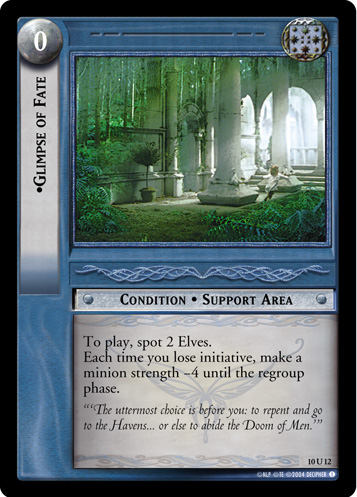

One could argue whether initiative itself was a mistake, but one would have an easier time arguing that making losing initiative good was a mistake, and an even easier time arguing that Elves, of all people, do not need the help trivializing minions.
Both the strength loss has been reduced and the ability to repeat the ability more than once per turn via Shenanigans has been eliminated.
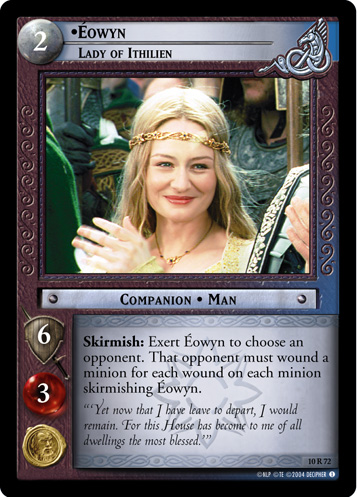

Eowyn’s ability has always been powerful and flexible, and perhaps a bit too flexible, when it could be combined with archery or direct wounding or just a horse and multiple uses. Her ability is left available to splash, but restricted to once per turn unless you pair her with another of the Rohirrim.
PC-Expanded Misc. Nerfs
Sites first! Because why not.
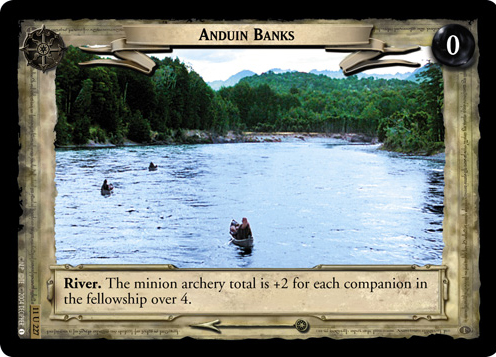

This is a slight nerf, except in the situation where there are 8 or 9 companions in region 3, which seems fair. Here’s a table showing the difference (ignore the middle column):

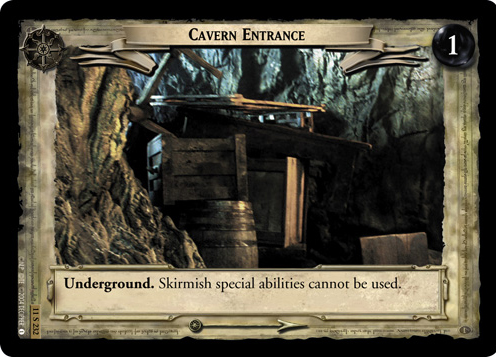

Ah, Cavern Entrance. Wonder of many an uncounterable bomb. The effect has been altered to a skirmish-by-skirmish trigger, which means that the Free Peoples player may be able to dodge its ability in the right circumstances, by carefully assigning any exhausted minions (or minions who might become exhausted).
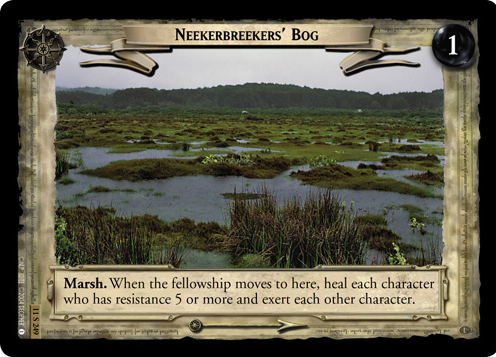

One of the commonly-abused sites in Expanded site manipulation, this has been restricted to only working its magic in regions 1 and 2 (i.e. while sanctuaries might still help you shrug it off).
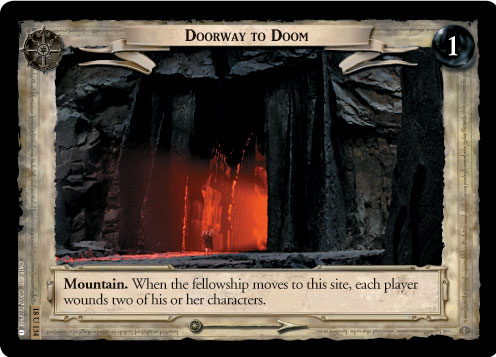

Another frequently-abused card, this one has been given a treatment that makes us wonder why it wasn’t default, considering its proximity to, well, Mount Doom: this site may not be replaced (like how Mount Doom blocks all sites in the current region from being replaced).
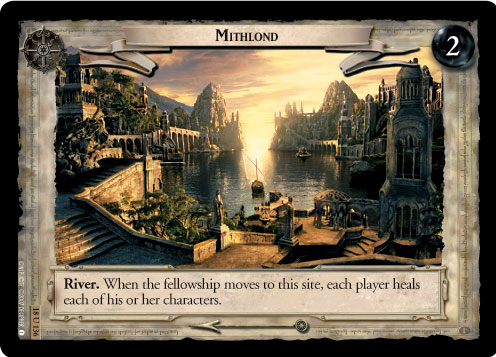

Another of the usual suspects when it comes to site manipulation, Mithlond now only works in region 3, meaning that it can’t be used as a mini-sanctuary until all your regular sanctuaries have run out.
And speaking of sanctuaries…
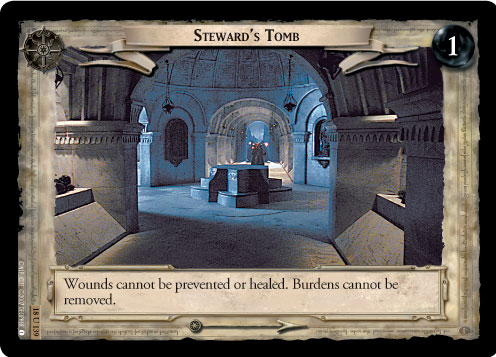


That’s right, ladies and gentlemen, it’s a Greatest Hits series of abusable sites, and this one’s the Big One. So big, in fact, that we couldn’t help but split its effect in two: one card (the original) for the original heal-and-burden-removal-blocking effect anywhere except sites 3 and 6, and another that only works at 3 and 6, reducing–but not eliminating!–the Fellowship’s access to standard Sanctuary healing.
This way an option is left open to Shadow decks needing to cut down on removing their hard-won wounds, without the utter demoralizing move of eliminating healing entirely.
(Although, it does seem like something’s missing, yeah? And there’s still half a line open…anyone have any suggestions for what we might put there to sweeten the deal?)
That’s it for sites, but there’s so much more to deal with in Expanded! …oh, so, so much more….
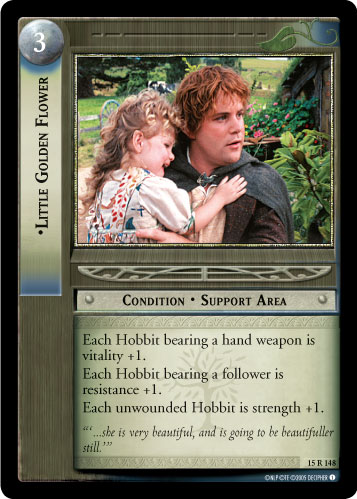

This card is plenty powerful as it is, but adding vitality to an already very vitality-heavy culture is pretty over-the-top. It’s annoying to track as well, as it is the only card in the game that grants vitality without having the symbol on the side while attached to the affecting card.
The problematic effect has been replaced with a wound-prevention one instead, which is still in the realm of vitality-expanding without being so egregious.
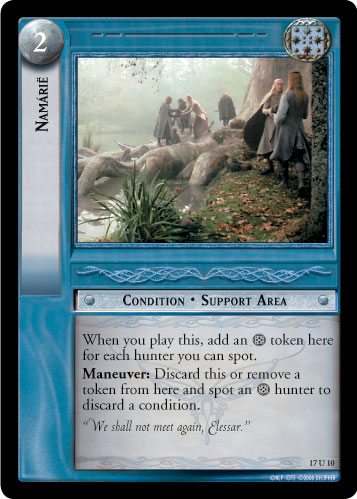

Namárië is busted strong; in a culture that specializes in removing conditions, it still manages to stand out from the pack. The conditinitial token generation has been capped, and each condition discarded now costs a card from hand, which is harder to game via reinforcement. It’s still probably too powerful in combination with other token-spawning cards, but we’ll just have to keep chiseling away at PC-Expanded’s high-octane power level until it’s safe to revisit.
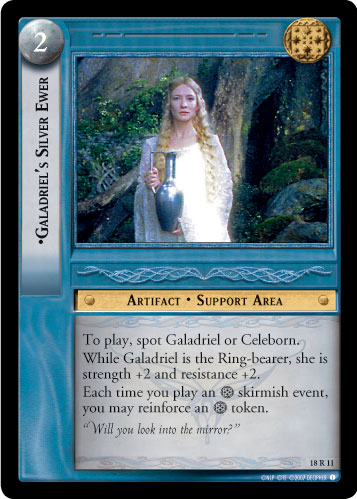

A simple number nerf and requiring Galadriel to at least exert if she’s gonna boost Namárië (or others).
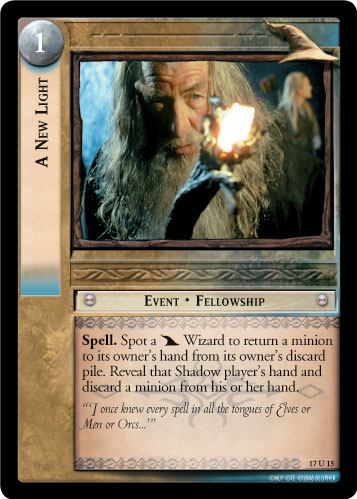

A New Light is just flat out too strong, replacing whatever your opponent’s most powerful minion is with whatever the weakest minion in his discard pile is (not to mention the intel of revealing their entire hand). The ability has been nerfed to return 2 minions to their hand, which at least has a chance of being a better trade.
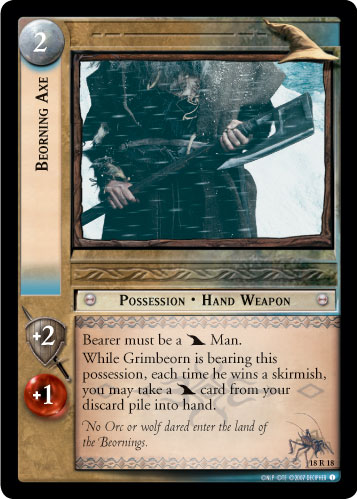

What’s this? Being able to take Servant of the Secret Fire back into hand to re-use on each of Beorn’s skirmishes, or any number of other useful Gandalf spells, on top of the +1 vitality from an…axe? This has been rightfully dunked down to only triggering once per turn.
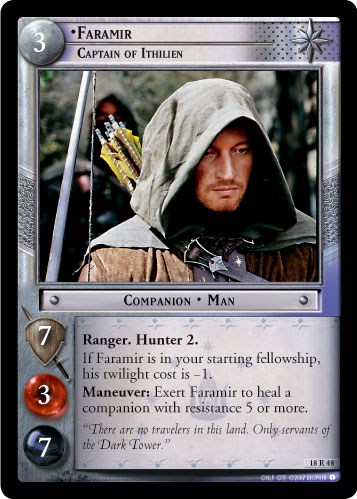

Sharp-eyed readers will note that Faramir himself is a companion with resistance 5 or more, meaning that you can use this ability over and over to no effect. Well, unless there was a card that triggered each time Faramir exerts, which blocks special abilities with impunity. Then it might get a little out of hand.
All that has been done is whip the ability’s text until it no longer works to target Faramir himself.
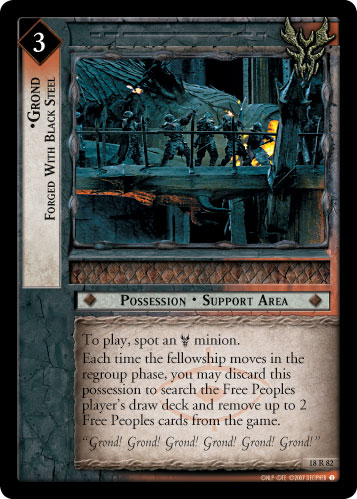

Straight up deleting any two cards from the Free People’s draw deck before they ever see the light of day is a bit much. The effect has been altered to discarding instead, and to compensate for the regroup-move dissuasion, Freeps is now required to put two cards from their hand in the deck first (which, during a double is likely to hold any backup Freeps events and such).
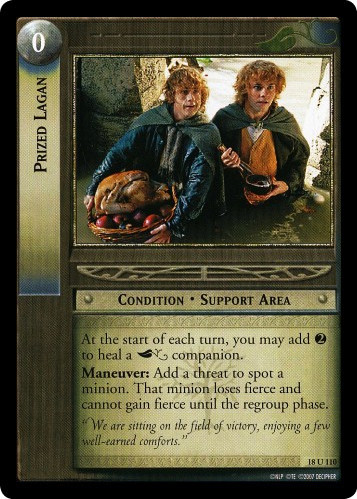

A threat for a skirmish is a pretty good deal, especially if you were going to lose the skirmish. To make the deal a little less of a steal, a twilight prevention clause has been added which, ironically enough, can be provided by the healing ability if it is so used.
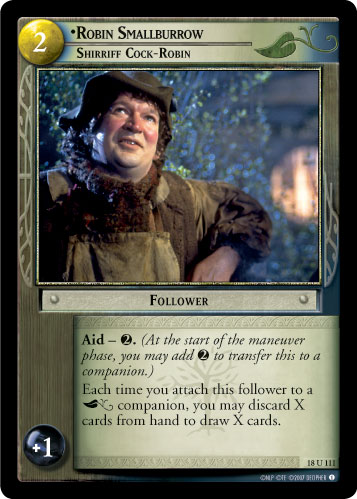

Cycle any number of cards, every site, all for the low low cost of 2 twilight! This has been reduced to merely be as good as an Ottar every Maneuver phase.
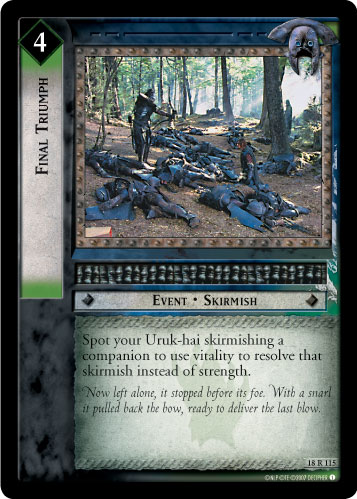

This card is essentially an insta-kill in most situations that it’s used; a 4 vitality uruk against a 2 vitality character, or a 2 vitality uruk against an exhausted character, ends in an overwhelm, and no amount of wound prevention or other tricks can save you. Preventing the overwhelms like this does nothing by default–both of the above examples still result in a dead companion (assuming the uruk has any damage bonuses), but now Armor or Intimidate or whatever can be burned as a resource to keep companions alive.
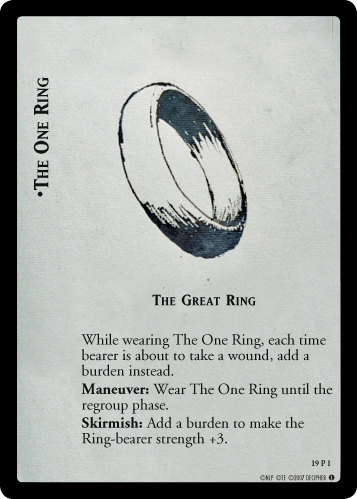

The Great Ring is the best skirmishing Ring ever produced by far. With a maximum strength bonus of around 33 strength depending on how much resistance you have, there is literally no skirmish that you could possibly be surprised by so long as this is in your back pocket, and that doesn’t even take into account removing burdens mid-skirmish.
To cut down on its ability to build up endlessly, a clause has been added such that putting on the One Ring prevents burdens from being removed so long as its on, and also requires that the Ring be worn to be able to utilize its strength boost. No more endless strength, and you have to risk at least a little resistance if you’re going to be using it to fight.
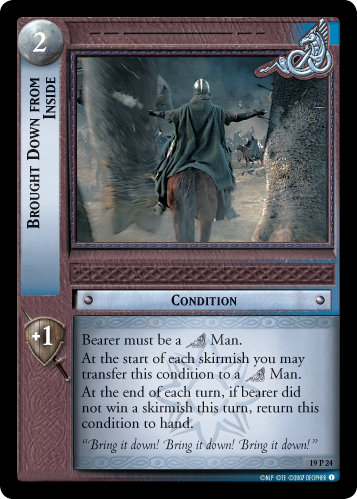

Short and sweet: it’s now unique. No more +4 rotating bonus.
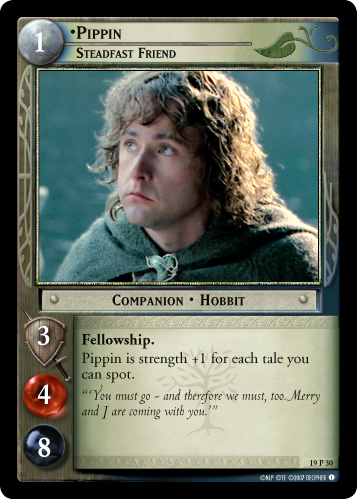

If there’s anything more emblematic of the power creep of late-era LOTR-TCG, it’s Pippin. Set 1 Pippin prevents your tales from being discarded. Set 19 Pippin casually walks around with as much strength as Sauron.
Pippin is now restricted to no more than +9 strength, and more realistically +4 or so.
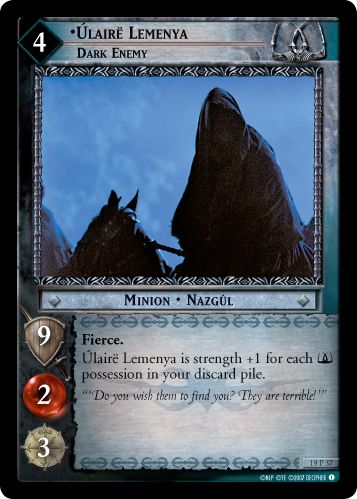

Of course, at least Pippin requires cards to be in play, while Mr. Discarded Armory here flirts with the low 50s in strength if you play your cards right (or don’t, as the case may be). Another +9 limit.
The Grand Discard Rework
A Negative Play Experience, or NPE, is different from a card being merely overpowered or too strong. An NPE is when a card or mechanic is degenerate in the sense that it contradicts the basic reason for sitting down and playing the game.
In most card games, you are (bear with me) attempting to sit down and play your cards. It’s okay if your opponent plays better cards, or plays cards more cleverly than you, but if you are made inherently unable to play your cards at all, then you have to wonder what the point was in sitting down in the first place.
Discard decks are not overpowered or difficult to beat. You simply throw out any pretense you had of coming to the table with a fine-tuned deck, you run like a madman down the site path, and you win. Or else you cling to the plan you started with, and watch your hand get disintegrated site after site, alongside your deck getting eaten away little by little, until the number of cards you didn’t play outstrips the cards you did play by a large margin.
The discard deck is not strong! It is not OP. But it makes you question why you didn’t concede immediately, even if you win. It is, in short, an NPE.
With this errata batch, we are taking a systematic approach to excising this NPE from FOTR block. We are not satisfied with deleting those cards from the game via banning, and in fact we are also not satisfied with merely blanking those cards out and replacing the text with something else entirely.
Instead, we looked to Desperate Defense of the Ring, which out of all of the discard cards does not feel quite so toxic, somehow. We realized that this must be because of the choice, that even though it is making you choose between two horrible results, you still have the agency to decide which is the least painful path in the moment.
Ironically, after applying this formula to each card, For balance purposes, many cards which affect the draw deck typically had their numbers increased to compensate for the fact that it was no longer a guaranteed hit. In some cases, the increase was dramatic, but that’s what it took to make it work as an alternate choice.
In addition, Free Peoples cards which discard from the draw deck have been altered to discard from the bottom of the deck instead of the top. The topdeck discard is now reserved for more offensive and targeted cards, which in practice meant every Shadow card.
With that out of the way, let’s begin:
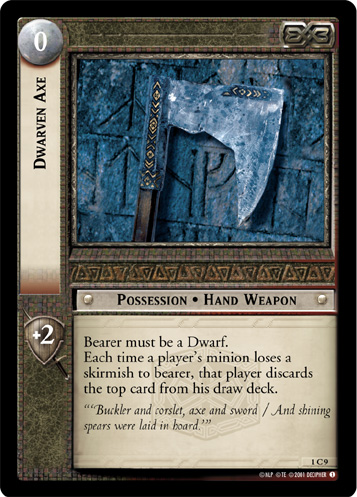

1 top card -> Shadow must exert a minion or discard the bottom card.
Remember that if you win a skirmish, you get to choose between resolving this card or the skirmish first, and you almost always want to choose the skirmish, lest your opponent choose to exert the minion you’re about to turn to paste.
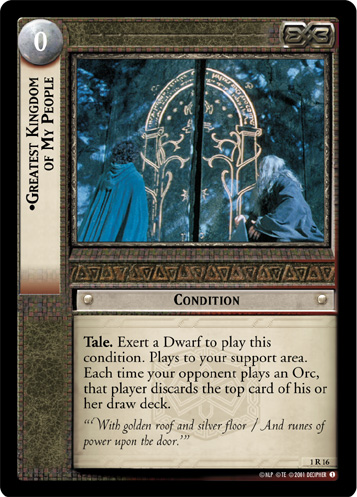

1 top deck per Orc played -> 1 recycled Dwarven card from discard or else bottom 2 cards.
This is restricted to once per turn, because otherwise it loops too easily with Nobody Tosses a Dwarf (below).
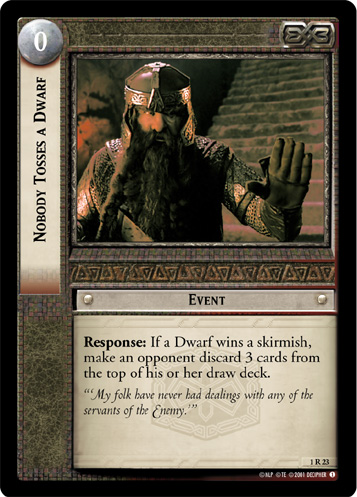

3 top deck -> discard a Shadow card, or else bottom 3 cards.
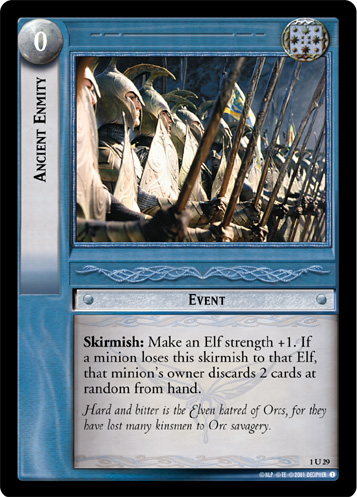

2 cards at random from hand -> heal an Elf or else discard 1 chosen card.
The prevention clause applies only to the heal and not the event as a whole.
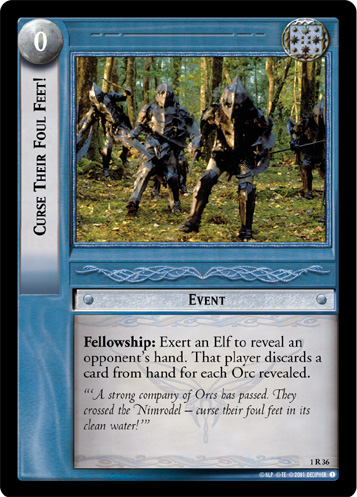

Discard 1 card from hand per Orc in hand -> reveal 4 cards from hand and make the Fellowship archery total +1 per Orc revealed unless a card is discarded for each Orc.
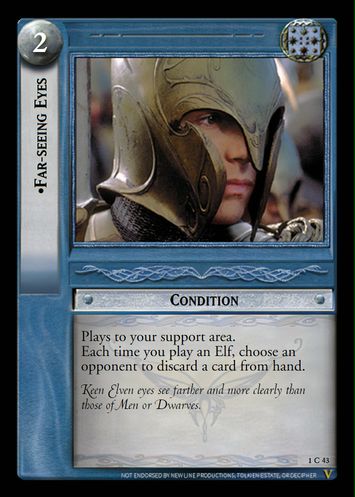

Discard a card from hand -> draw a card, or Shadow may discard a card to prevent it.
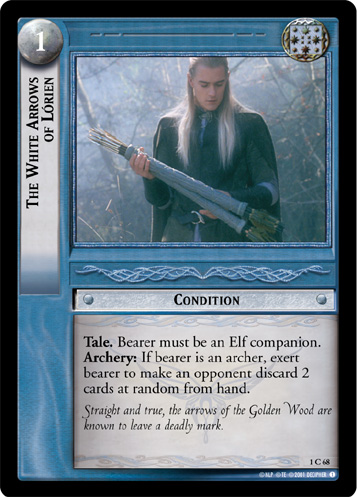

Discard 2 cards at random from hand -> exert a minion, or else discard a card from hand to prevent it.
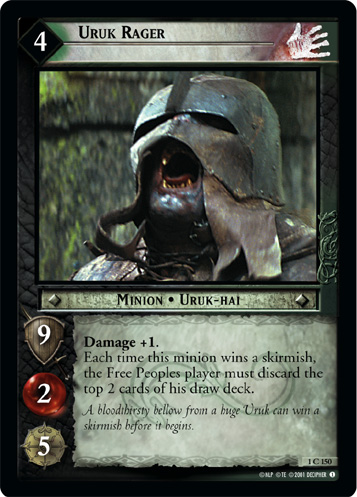

2 top deck -> exert a companion, or else discard top 3 cards from deck.
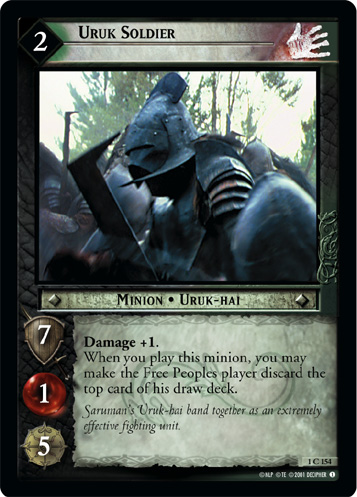

1 top deck -> pick a companion to exert, or else they discard 2 top deck.
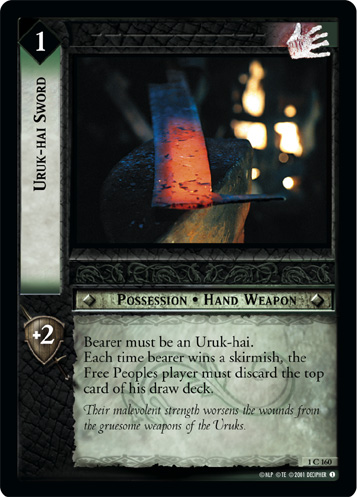

1 top deck -> exert a companion, or else discard top 2 cards from deck.
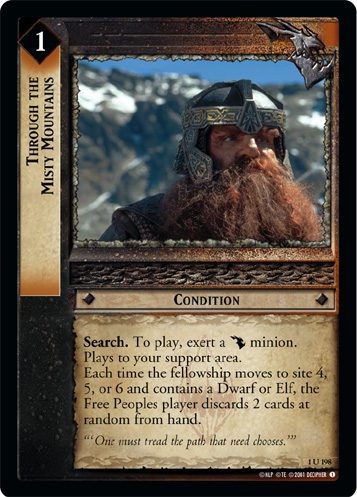

Discard 2 cards at random from hand -> draw a card or else discard a card at random from hand.
This card was also altered to work at “any site 4, 5, or 6”, as part of our initiative to abolish block-restricted effects.
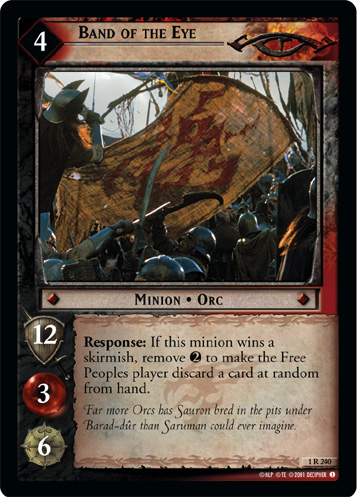

This had a few different changes. First, the Response (which can trigger multiple times, infinitely even if you have enough twilight) is changed to a more intuitive Each Time trigger. To compensate for the lack of repeatability, the effect is doubled to 2 burdens or 2 cards at random from hand.
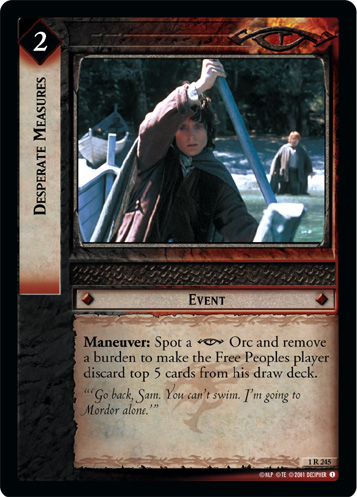

5 top cards -> take a Sauron card into hand from discard, or else Freeps discards 8 top cards.
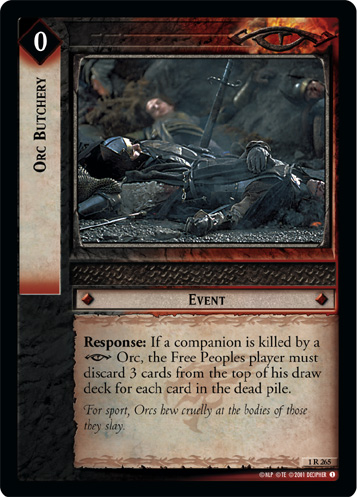

3x top deck for each card in the dead pile -> 1x burden or discard 4x top deck.
The Free Peoples player decides for each card, so they could alternate choices or split it up however they like.


Discard a card at random from hand -> draw a card, or else prevent that by discarding a card at random from hand.
The interrogator either gains knowledge or makes you lose a pieces of yourself…
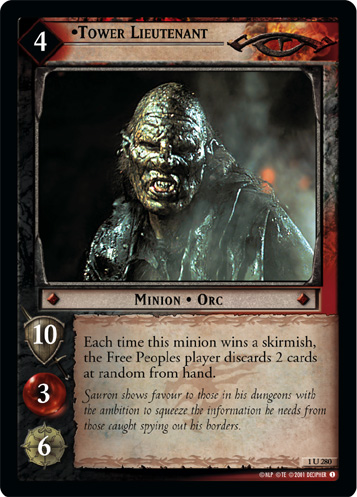

2 cards at random from hand -> choose a companion to exhaust unless Freeps discards 2 cards at random from hand.
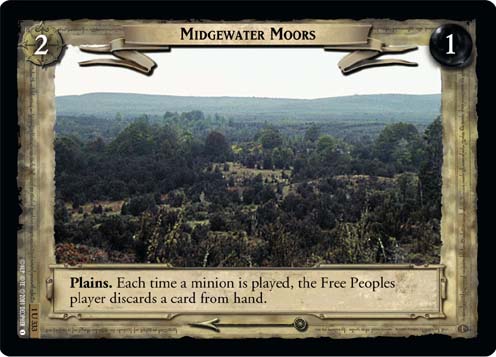

Discards a card from hand -> exert a companion or else discard a card from hand.
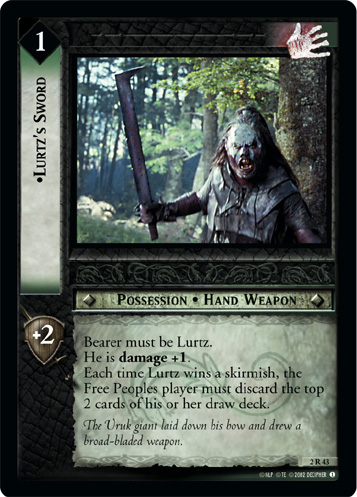

2 top deck -> wound a companion or 3 top deck.
This is a better Uruk-hai Sword, of course, but it can be very difficult to justify including such restricted possessions in your deck. We’ve thus backported a common design pattern from later in the game to make it work on more uruks than just Lurtz, reducing the number of stars that have to align for you to play it.
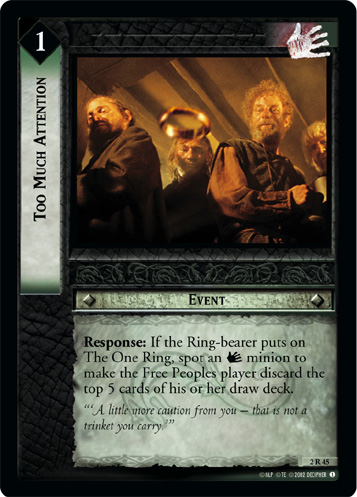

5 top deck -> tutor a minion of any culture from deck into hand, or else discard 5 top deck.
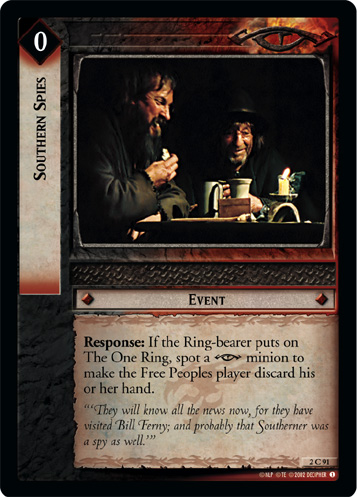

Discard the whole hand -> Add a burden for each card in hand, or else discard it all.


Discard X cards from hand -> take a minion into hand costing X, or else discard X cards from hand to prevent this.
Since hands will usually be 7 or less, this can be unblockable.


This card was completely reworked, not for any power concerns but because the name “Get Off The Road” just screams move limit shenanigans. The spotting requirement has been reduced to a Sauron card instead of a Sauron minion, too.
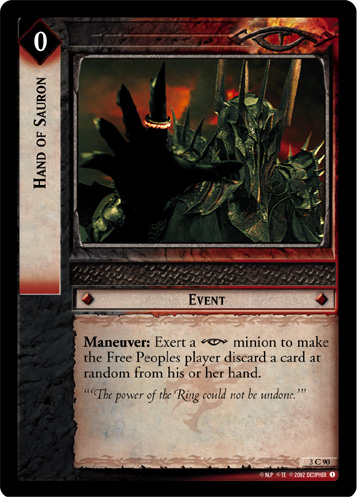

Discard a random card from hand -> exhaust a companion, or else discard 2 cards at random from hand.
The cost was increased to require a unique Sauron minion, as well.
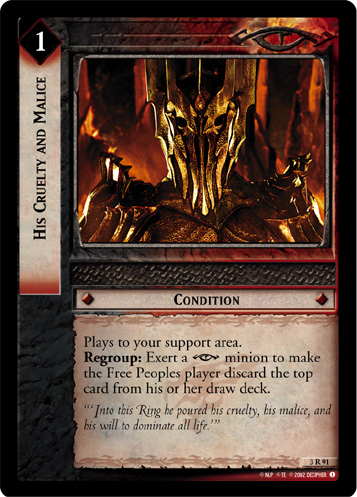

Another overhaul, although in this case it was due to the standard choice (originally “exert or discard”) being way too powerful. The new version is randomly self-limiting; if no Freeps cards are in the top 2, then further uses of the ability won’t work, but so long as any do show up, you can use up all your spare vitality with impunity, either getting more exertions or making Freeps discard their hopes and dreams. Cruel indeed.
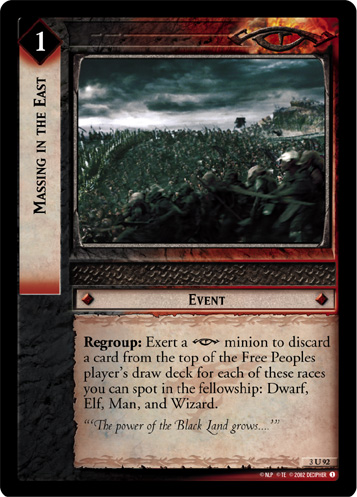

X top deck -> return X minions to hand, or else discard X cards to prevent.
The cost was increased from exerting a minion to discarding it.
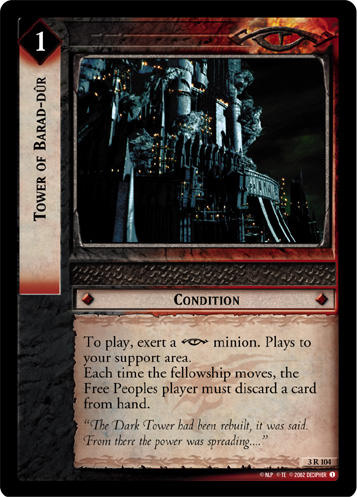

Discard a card from hand -> Draw 2 cards, or else Freeps discards a card from hand.
This is still non-unique, which can make the bonus multiply and may turn around to bite you.
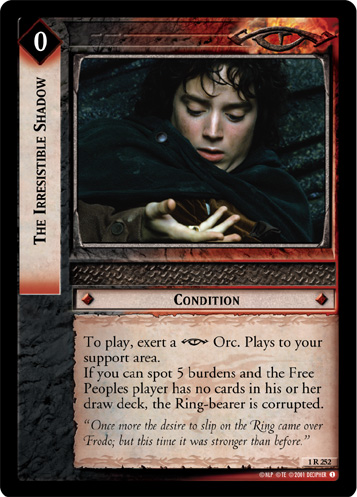

Finally, the capstone, the win condition for the discard deck. In a lot of ways, this is the reason for the discard deck’s existence; it’s only upon seeing this card as a new player that your mind thinks back to all the discard cards you’ve glossed over, and possibilities start flying to mind.
In this case, it is justified to put that to rest. An empty deck is its own reward, if that’s the sort of reward you really must pursue, but this siren’s song will no longer call out, beckoning new players to join its ranks of victims. It was Irresistible, but not to the right target.
Instead, a temptation is offered to the Free Peoples player, and a dark horse hail-mary win condition is offered to a variety of decks. Keep the card on the table, the card whispers, and your Ring-bearer will be able to handle what will come.
But if he is alone, then resistance crumbles. The math works out to essentially making Frodo have 4 Resistance, and Sam 2. How many matches have ended with Frodo all alone, exhausted, with only a burden or two from corruption…? This might have saved you.
Maybe you won’t be able to resist including it for next time…
